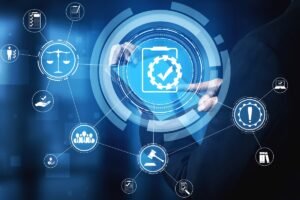Discover how AI in robotics is reshaping automation with human demonstration, synthetic data, and digital twins. Learn how it’s solving real-world problems in factories and beyond.
Table of Contents
Why AI in Robotics is a Game-Changer
If you are someone keeping an eye on tech trends, you have probably heard a lot about AI in robotics lately. But why is this such a big deal?
Let me tell you it’s not just about robots that look cool or can flip burgers. It’s about transforming industries. From logistics to electronics, robots powered by artificial intelligence are learning like humans, making decisions in real-time, and solving real-world problems faster than ever.
And at the heart of it all? Data. Tons of it. And the smarter we get at creating and using that data, the better these robots become.
From Human Demonstrations to Generalist Robots
Here’s a fact that might surprise you training a robot starts off just like teaching a child.
You show them how to do something a task, a movement, a pattern and the robot learns through demonstration. That’s called teleoperation. Picture it like a coach guiding an athlete.
But here’s the rub if you want to teach dozens of tasks, you’d need an army of operators. And guess what? That’s just not scalable.
So what’s the solution?
Synthetic Data
Now, instead of manually showing each task over and over again, engineers are using synthetic data essentially fake data generated by AI that’s based on real-world examples.
AI models like NVIDIA Cosmos step in to do the heavy lifting. With just one recorded demo, these models can generate millions of variations, creating a flood of training data.
This is where tools like Groot Dreams come into play. These systems help turn 2D dreams (generated videos) into 3D action plans, which robots can then mimic in real life.
Meet Groot Dreams and Cosmos
Sounds like a sci-fi movie, right?
But Groot Dreams and Cosmos are real tools used in the robotics industry today. Think of it as using one AI to train another AI.
Here’s how it works:
- Human demonstrates a task in one environment.
- AI generates “dreams” of the same task in new environments.
- AI evaluates which dreams are useful.
- 3D trajectories are extracted from those videos.
- Robots learn from them just like that.
This tech slashes manual effort and amplifies training speed, allowing small teams to do what used to take hundreds of hours.
If you are building robotics software, start looking into AI foundation models like Cosmos. They’re changing the game.
Digital Twins
You have probably heard the term digital twin floating around. But let me break it down real simple for you.
A digital twin is just a virtual copy of a real-world object like a factory, machine, or even a robot. You can simulate, test, and optimize in the digital world before you touch the real thing.
Companies like TSMC, Foxconn, Quanta, and Pegatron are already using NVIDIA Omniverse to create fully simulated factories. These aren’t your average CAD files. They’re full-blown simulations that help:
- Reduce production errors
- Save time and cost
- Prepare for robotic automation
How AI in Robotics Helps Solve the Labor Shortage
Let’s face it there’s a serious labor shortage in manufacturing, logistics, and even retail.
That’s where humanoid robots come into the picture. Unlike traditional robots, these don’t need specially designed spaces. They can just walk into your existing factory (called brownfield deployment) and start doing the tasks humans designed for humans.
Imagine having a robot that understands your workspace, your tools, and your processes and can learn new ones through AI.
That’s what makes humanoid robotics the next multi-trillion-dollar industry.
Read More How Gemini Robotics Is Redefining the Future of Physical AI Agents in 2025
Why the Future Is All About Humanoid Robots
Here’s what most people miss humanoid robots are not just sci-fi fantasies. They are the next phase of industrial growth.
But making them is not easy. You need:
- Three computers per robot: one for training, one for simulation, one for deployment.
- Massive compute power
- Reinforcement learning from synthetic data
- A real-to-real learning loop
Still, once this flywheel starts turning, there’s no going back. Every robot that learns, teaches the next one faster and better.
FAQs About AI in Robotics
Q. What is AI in robotics used for?
Ans. AI helps robots perceive, make decisions, and learn new skills. From picking items in warehouses to assembling electronics, AI makes robots smarter and more useful.
Q. What are digital twins in manufacturing?
Ans. A digital twin is a virtual simulation of a real-world object or system. It’s used to optimize design, prevent downtime, and simulate robotic workflows before deployment.
Q. How do robots learn from synthetic data?
Ans. Synthetic data is created using AI models based on real demonstrations. This data trains robots to perform new tasks without manual input each time.
Q. Are humanoid robots already in use?
Ans. Yes, early versions are being tested in labs and pilot factories. Companies are building toward scalable, flexible deployment in real industrial settings.
Q. Is NVIDIA leading the AI robotics revolution?
Ans. Absolutely. Tools like Omniverse, Cosmos, and Groot Dreams are at the core of NVIDIA’s robotics ecosystem.
Conclusion
If you are serious about understanding the future of automation, AI in robotics is where the action is. The combination of human demonstrations, synthetic data, and digital twins is accelerating robot development faster than ever.
And whether you are a developer, factory manager, or just a curious tech enthusiast now’s the time to learn and get involved.





Pingback: Meet the Most Advanced Robots Changing the World Today in 2025 - Pickn Reviews